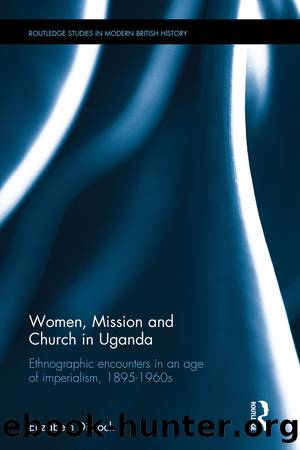Women, Mission and Church in Uganda by Elizabeth Dimock

Author:Elizabeth Dimock [Dimock, Elizabeth]
Language: eng
Format: epub
ISBN: 9780367275341
Barnesnoble:
Publisher: Taylor & Francis
Published: 2019-04-11T00:00:00+00:00
Conclusion
Missionary work with women and girls had been expansive and attracted large numbers to the day school, and later the weavery, in the period 1900 to 1913. Mission work was maintained under the Mukamaâs aegis. Womenâs Work was developed, and Mission and Church structures created opportunities for women as catechists and teachers, and in Womenâs Church Councils, albeit subject to the controls of menâs Church Councils and the clergy. Bahima women, particularly those in the royal household, were drawn to the work of the Mission, participating in the weavery insofar as they were interested. Ana Kageye was closely involved in the operation of the school and to a lesser extent with the weavery.
Missionary discourse was concerned with âraisingâ the level of womenâs lives. The work of the Reformatory went beyond the bounds of reading and writing, spinning and weaving, all of which were sought after, being to some degree prestigious. Reformatory work came directly into conflict with traditional values relating to sex, marriage and society. It attempted to impose notions of sinfulness and an alien ethos in ways that were not readily acceptable by many in the community. It brought Batoro women in touch with moralising, disciplining â English middle-class culture at its most repressive. For some, moral authority was absorbed enhancing their position in the changing society. But in the changing fortunes of the industrial mission and the Reformatory, ordinary women at times protested against the methods of Miss Allen, which stemmed from the discourse of the Church and nineteenth-century evangelicalism. Their protests demonstrated the power of agency, and their unwillingness to submit to controls imposed on them with which they did not approve.
Annie Emma Allen was the central figure in the effort to establish industrial training. Ruth Fisher, née Hurditch, had moved on to other mission stations by this time, and Edith Pikeâs main interest was in schools for boys and girls that continued to flourish. While Edith Pike and Ruth Hurditch have retained high status in the collective memory of the Batoro, commemorated in the Mothersâ Union pageant in 1965 and in the personal memory of Christian women such as Mrs Muntukwonka, who talked with me in 1991, Miss Allen seems unremembered. None of my interviewees could recall any discussion concerning Miss Allen, nor memory of, or reference to the fire that destroyed so much of the industrial equipment in 1913. My wondering suggests that memory of past events in the colonial encounter relates to the nature of the experience.
Each of these three female missionaries represents the colonising influence of women in the CMS in the early years of the Uganda Protectorate. Yet individually they were different from each other, and my reading of the archives suggests that their relations with the Batoro were also varied.
Download
This site does not store any files on its server. We only index and link to content provided by other sites. Please contact the content providers to delete copyright contents if any and email us, we'll remove relevant links or contents immediately.
| Central Africa | East Africa |
| North Africa | Southern Africa |
| West Africa | Algeria |
| Egypt | Ethiopia |
| Kenya | Nigeria |
| South Africa | Sudan |
| Zimbabwe |
Goodbye Paradise(2971)
Men at Arms by Terry Pratchett(2408)
Tobruk by Peter Fitzsimons(2064)
Pirate Alley by Terry McKnight(1910)
Arabs by Eugene Rogan(1837)
Borders by unknow(1789)
Belonging by Unknown(1472)
The Biafra Story by Frederick Forsyth(1325)
It's Our Turn to Eat by Michela Wrong(1305)
Botswana--Culture Smart! by Michael Main(1238)
A Winter in Arabia by Freya Stark(1225)
Gandhi by Ramachandra Guha(1196)
Coffee: From Bean to Barista by Robert W. Thurston(1183)
Livingstone by Tim Jeal(1152)
The Falls by Unknown(1142)
The Source by James A. Michener(1135)
The Shield and The Sword by Ernle Bradford(1101)
Egyptian Mythology A Fascinating Guide to Understanding the Gods, Goddesses, Monsters, and Mortals (Greek Mythology - Norse Mythology - Egyptian Mythology) by Matt Clayton(1088)
Africa: Altered States, Ordinary Miracles by Richard Dowden(1078)
